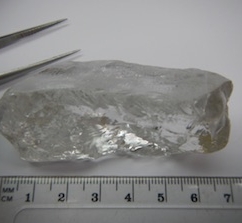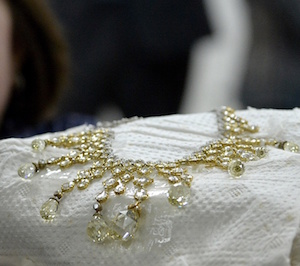Articles and News
Diamond Update: 404-Ct. Stone Found; Report Says Margins Unsustainable; Imelda Jewelry Auction; More February 17, 2016 (0 comments)

404-Carat Rough Diamond Found In Angola
Lulo, Angola—Australian mining company Lucapa announced Monday that a 404.2-carat rough diamond was found in an alluvial bed above its Block 8 at the Lulo mine here. The Lulo project is a partnership with Endiama and Rosas & Pétalas. Lucapa is the operator with a 40% interest in the alluvial diamond mining operations. Endiama has a 32% interest while Rosas & Pétalas holds 28%. Alluvial mining operations commenced at Lulo in 2015.
Confirmed to be a top-tier D-color Type IIA, the stone (shown above left) is the fourth diamond over 100 carats found at the Lulo mine, and the largest diamond found to date in Angola, a country prized for its valuable diamond resources. More than 60 large special diamonds have been recovered at Lulo in the six months since mining commenced in August of last year. The previous record for the Lulo mine was held by a 133.4-ct. piece of rough; the previous record for a diamond found in Angola was the “Angolan Star,” a 217-.4-ct. stone recovered from the Luarica mine in 2007.
Though no one has yet determined how this one will be cut, large diamonds such as this often are finished into multiple stones. For example, the Jonker, the fourth-largest stone ever found, was 726 carats in rough form, and eventually was cleaved by Lazare Kaplan into 13 stones. The largest of these weighed 220 cts. after the initial cleaving, and 142.9 carats after finishing into an emerald shape, while the smallest of the Jonker stones weighed 8.28 ct. after initial cleaving and finished to a 3.53-ct baguette.
The largest diamond ever found remains the famed Cullinan, now part of the British crown jewels. Its rough weight was 3106.75 cts. Though it was cut into only nine stones, many believe the Jonker was originally part of the Cullinan, as both stones had an identical face when cleaved.
25-Carat Barrel Shape Diamond Among Marcos Jewelry To Be Sold
Manila, Philippines—Imelda Marcos, widow of the late deposed Philippine dictator Ferdinand Marcos, was a modern-day Marie Antoinette who rose to infamy through her lavish shoe collection, but her jewelry collection walks all over it in terms of value, and it’s about to go on the auction block.

Diamond necklace is just one of many lavish pieces of jewelry Imelda Marcos showered on herself. Image: The Guardian.com
The jewelry has been in the Philippine government’s possession since being seized from various places following the Marcos’s ouster in 1986. Estimates from Sotheby’s and Christies auction houses place the value of the collection at approximately $21 million.
The haul includes a 25-carat, barrel-shaped diamond worth at least $5 million, and a Cartier diamond tiara once appraised at $30,000 to $50,000 but now believed to be far more valuable.
Some of the jewelry that was seized at the presidential palace in Manila is still being contested in court, but many pieces were seized by customs officials at the airport and by U.S. customs officials in Hawaii.
The Philippines’ Presidential Commission on Good Government is the agency tasked to recover the Marcoses’ ill-gotten wealth—in addition to the jewelry, more than 200 artworks including paintings by the likes of Van Gogh, Picasso and Rembrandt. The Philippine government’s Privatization Council under its Department of Finance last week approved the sale of the jewelry.
IDMA: Despite Market Uptick, Margins And Profits Suffering
Antwerp, Belgium—A report commissioned by the International Diamond Manufacturers Association underlines the continued deep dysfunction in the diamond market.
In a letter to members, IDMA president Maxim Shkadov said the current state of minimal (or no) margins and profits for diamond manufacturers and dealers can’t continue. IDMA tapped Edahn Golan Diamond Research and Data to study standard rough diamond assortments, their production costs and the resulting polish value, and the level of margins in the manufacturing part of the midstream pipeline. The report data covered January-July 2015; Shkadov says the rest of the year was no different.
The assortments studied were either borderline economical or uneconomical, says the report. Because better goods typically also carry GIA certification (especially above one carat), the cost of obtaining those reports was factored in, leaving the gross margin range from as low as -8.5% to just 1.6%. In dollar terms, the gross margin ranged from a $491 per-carat loss to $71 per-carat gross profit. When other factors are added to the calculation, such as the cost of finance, depreciations on hardware and software, related administrative costs or travel, then all goods appear to result in a loss.
The report also dives into the U.S. diamond market, which according to Golan’s figures is still declining. Golan attributes the drop in diamond demand to changing consumer preferences rather than the economy. Fine jewelry sales in the United States are on the rise since 2013, to the tune of about 1% per year; however, this factors in all fine jewelry, and suggests that diamonds are occupying a smaller share of market.
To read the entire report, click here.
DPA Taps Lieberherr To Lead
Antwerp, Belgium—The Diamond Producers Association (DPA) has appointed De Beers’ Stephen Lussier as chairman, Dominion Diamonds’ Jim Pounds as vice chairman and Jean-Marc Lieberherr as CEO, all with immediate effect.
Lussier is executive vice president of marketing for De Beers, as well as CEO of its Forevermark brand. Pounds is executive vice president, diamonds, at Dominion Diamond Corp., Lieberherr recently left his position as managing director of Rio Tinto Diamonds.
The three will work closely with the other DPA members to develop the organization’s objectives of maintaining and enhancing consumer demand for and confidence in diamonds, providing a reliable source of industry information, and communicating the role and contribution of diamond producers to the diamond sector and broader society.
In an address at Diamond Week in Israel, Lieberherr said, "The Diamond Producers Association can talk about how to make the diamond industry more successful. We try to make sure that we keep the diamond dream alive and to keep it as vivid as possible. De Beers used to hold an important role in this aspect and one of the objectives of the DPA is to fill that gap."
On the subject of marketing diamonds, Lieberherr spoke of research on Millennials the DPA conducted in the United States. "Many of these young people have never been exposed to diamond marketing. One of the things we observed from this research is that they reject the notion of convention. We need to connect to the younger generation on the emotional level. We need to translate to them the special qualities of the diamond. All the successful diamond brands have established the emotional connection.
At the same panel discussion, renowned international jewelry designer Stephen Webster credits diamonds as the item that has made his business a success. "My business has been driven by creativity. I've been a jeweler for 40 years, but it is only in the past 20 years that my business has blossomed. My clientele has largely been women buying jewelry for themselves. This might be the norm nowadays, but I don't believe this was the case back then."
World Diamond Mark Foundation chairman Alex Popov concluded, "We don't want to market diamonds by providing information on the 4Cs. We are going for the emotional connection. What we have to understand is that the luxury industry treats diamonds as a component. We need to do something about that. If we keep selling diamonds as a component only, then we will be squeezed out.”
WFDB Lauds Signet Responsible Sourcing Protocol
Antwerp, Belgium—The World Federation of Diamond Bourses (WFDB) announces its support for Signet Jewelers Ltd.'s Responsible Sourcing Protocol for Diamonds (D-SRSP), a protocol which aims to increase transparency in, and the integrity of, the global diamond supply chain. Signet launched the protocol on February 16. The protocol was developed with input from the WFDB, as well as other leading global diamond industry bodies.
"We believe this is an extremely important development and we are pleased to have been involved in developing the protocol," commented WFDB President Ernie Blom. "Signet, which is the world's largest retailer of diamond jewelry, is leading the way in requiring its suppliers to map their supply chains, mitigate risks and ensure complete transparency. This is critical in strengthening consumer confidence and, we hope, will lead other companies to follow this lead. We believe it is an excellent example of the industry working together to create an unimpeachable standard of cooperation that puts to bed any claims that the proceeds from diamond sales are being used for illicit purposes,” he said, adding that the industry knows it must take steps to assure consumers that it has nothing to do with any human rights issues or illegal labor practices in diamond-mining regions.
"The global diamond sector has proven over the past decade or so, since the establishment of the Kimberley Process, that it is among the best self- regulated businesses in the world. It invests a great deal of time, effort and income in ensuring that diamonds are mined responsibly and sustainably with a fair income for workers and that the supply chain is transparent. We believe the Signet protocol will take this to an even higher global level and support it wholeheartedly," Blom added.







